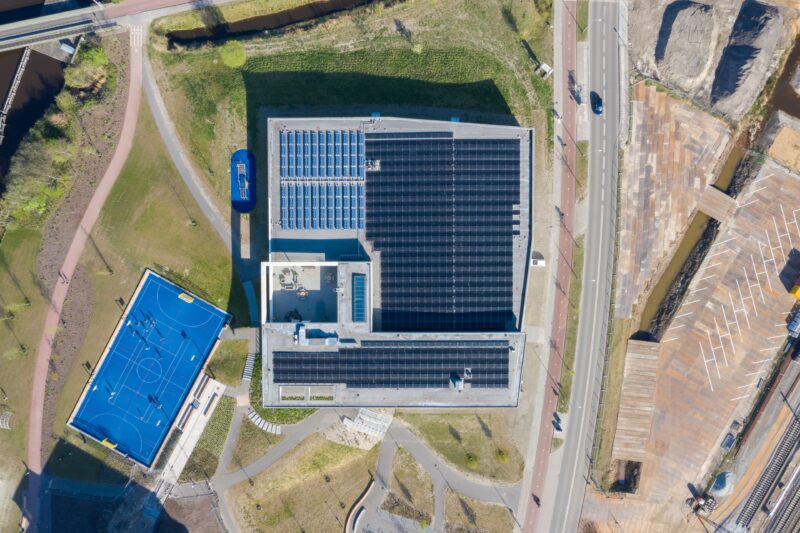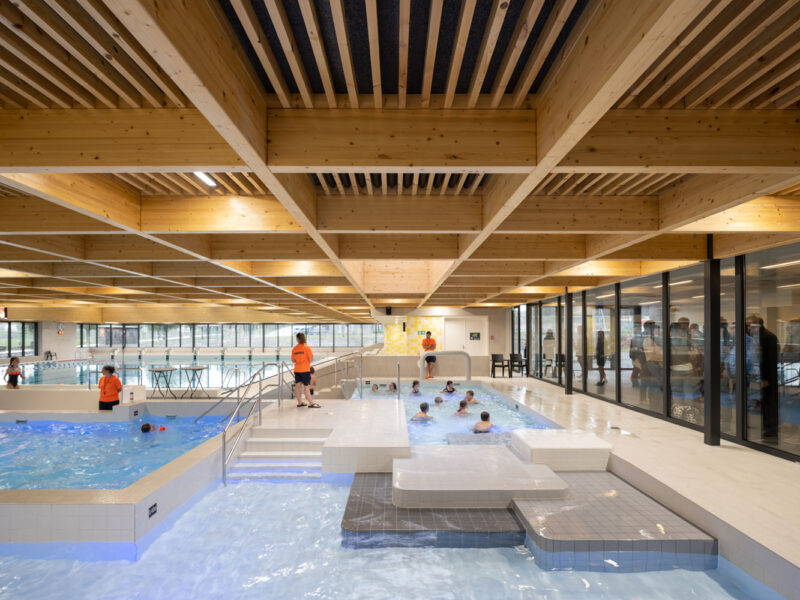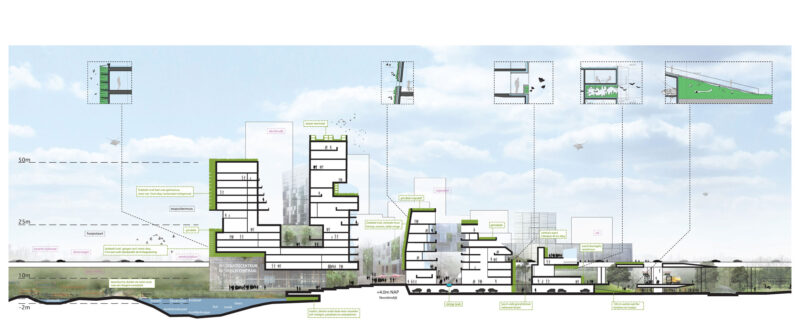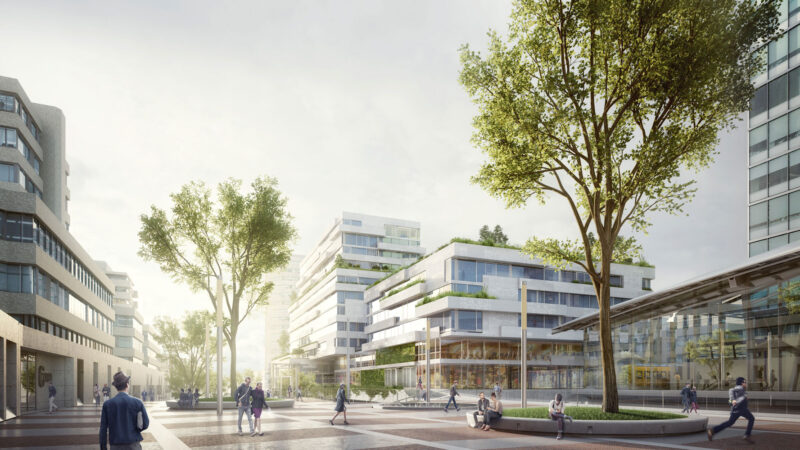Challenges and responses
Climate Change
It is by now extremely likely that the current climate change is caused by human activity, as opposed to past changes in climate, which have resulted as part of Earth’s natural processes. Climate change brings along a plethora of direct and indirect problems, such as extreme weather (heat waves and hurricanes in northern Europe and deserts in the Mediterranean), rising sea levels, drought, floods, loss of agricultural land and threats to public health, security, and economies.
Causes:
The main cause of the current climate change is the increase of greenhouse gasses in the atmosphere. The Kyoto Protocol lists several greenhouse gases, but the major ones are carbon dioxide, methane, and nitrous oxide.

Energy-neutral Sports complex Europapark, Groningen (commissioned 2015, realized 2018). Photo: Ossip van Duivenbode
What can we do?
- Reduce emissions: We have to urgently reduce the emission of greenhouse gasses and pollutants. In fact, we need to go a step further and develop a post-fossil culture with carbon-negative economies.
- Prepare: As architects and urban planners, we also have to create designs that will withstand the challenges that we know will come in the near future. This means adaptive design of buildings and cities that takes into account sea level rise, heat waves, drought, and floods. Dutch planners are the world’s frontrunners in adaptive design. Create well-functioning cities: see boxed text
- Harness technology: see boxed text

Floating MicroCities, Amsterdam/Almere (design research 2014)
Technology
Scientists and engineers are looking into ways to solve our environmental problems with technology.
In the field of geoengineering, we see proposals for removing some of the CO2 from the atmosphere and storing it in other parts of the environment. Other proposals include: injecting reflective aerosol into the stratosphere to create a cooling effect; brightening clouds with sea water; planting genetically modified trees that absorb more carbon; and pumping iron fertilization into the ocean to promote carbon-absorbing marine organisms.
Then there is the materials revolution, in which silicon and other materials are replacing materials in common uses. Nanotechnology and other emerging technologies may also find substitutes for scarce materials. At VenhoevenCS, we are following these developments with interest, but we cannot rely on substitutes that still need to be invented. We also do not want to put our bets on a new material if we are not sure what harmful effects its production could have (e.g. graphene).
In agriculture, there are many technological developments underway, from high-tech indoor farms to genetic engineering and cultured meat.
We at VenhoevenCS are keeping track of technological developments, but always with a critical eye and reflective approach.
Natural resource depletion
We humans depend on many natural resources to live and to produce goods. There are three different types of natural resources:
- Inexhaustible resources, such as solar, wind energy and geothermal energy
- Renewable resources, such as trees, topsoil, and fresh water
- Non-renewable and exhaustible resources, such as fossil fuels, metallic mineral resources (iron, aluminium, copper, and rare earth metals), and non-metallic mineral resources (salt and sand).
We are used to harvesting, sourcing, and mining from nature what we need. But we are now mining and harvesting natural resources at an alarming rate. Exhaustible resources are being depleted, leading to material shortages. Even renewable resources are extracted so quickly that regeneration cannot keep up, resulting in deforestation, soil erosion, and degradation. In many places, fresh groundwater, mined sand, and gravel – extensively used in construction – are now considered non-renewable resources.
To overcome these issues, we need to change our practice and create an ecological civilization. We need to improve Earth’s carrying capacity by introducing sustainable and resilient urban planning strategies and transform our linear economy into a circular one. By improving research and education, we can achieve this.
Causes:
- Overpopulation: With seven billion people on the planet expected to grow to twelve billion by the end of this century, the demand for Earth’s resources continues to increase
- Overconsumption and waste: an excessive and unnecessary use of resources
- Harmful mining and harvesting methods that pollute or contaminate resources
- Harmful agricultural methods, like clearing forests
- Soil erosion
- Harmful water extraction, like the use of fossil water
- Technological and industrial development.

Blocks B&C: high ambitions for self-sufficiency in energy and water
What can we do?
- Conserve energy: We urgently need to reduce our energy consumption because our current increase in energy consumption cannot be met by renewable resources. In projects we can also do a lot, such as design walkable neighbourhoods and energy-producing buildings. Create well functioning cities: see boxed text
- Develop renewable energy: For the energy that we must use, we need to transition from fossil fuels to renewable energy.
- Substitute concrete and steel for biobased materials like wood.
- Reuse, recycle, and upcycle: see boxed text
- Reduce waste: see boxed text
- Dematerialize: digital developments (paperless, streaming and software)
- Conserve and reuse water: in the water-rich Netherlands, it seems strange to conserve water; but we are already facing more droughts, salinization, and groundwater depletion here too. Moreover, creating potable water uses a lot of energy. Design can make a difference: rainwater harvesting, grey water systems, and natural wastewater treatment. Create well functioning cities: see boxed text
- Harness technology: see boxed text
- Promote inclusive economic growth: see boxed text

Wooden roof at ‘t Rosco pool in Ronse in Belgium (design 2016, built in 2019). Photo: Ossip van Duivenbode
Reuse, recycle, and upcycle: going circular
Reduce waste
Closing resource cycles by creating a circular economy is one of the most important solutions, but also one of the hardest, because this involves a complete rethink of the entire supply chain and inventing new business cases. This is also the field most prone to greenwashing. More research and consensus on what constitutes ‘circular’ are urgently needed here. But still there is plenty that we as architects and planners can do right now, such as designing with the help of Life Cycle Costs Analysis (LCA). Other possibilities include supporting attempts to create sustainable circular agriculture closer to home and substitute harmful practices elsewhere, by boosting metropolitan and urban agriculture.
A zero-waste world where everything is re-used is probably an unattainable utopia, but we can instead focus on reducing waste. Think of construction waste management or adopting new manufacturing and distribution processes that produce less waste. One major possibility here is for many future products to be made using 3D printing.
Introduce inclusive economic growth
It is hard to make a sustainable city overnight. Good management, well balanced government incentives, and long-term measurement of progress are needed to steadily improve performance. Sustainable economic development is a vital aspect of a city’s sustainability performance; proper management of inclusive economic growth is one of the key success factors of its development. Inclusive economic growth is more than just monetary growth, because it not only looks at production, but also takes into account the change in stock value. If the stock value of natural resources and human, social, or manufactured capital diminish, they must be calculated as negative values in the balance sheet. This way, the current, linear economy looks much less profitable than a circular one, as stocks in the latter increase instead of decrease.
This reasoning is based on the four capitals approach by Joseph Stiglitz (recipient of the Nobel Memorial Prize in Economic Sciences ) as applied by the EU and World Bank. This approach can be used by governing bodies at all levels to balance inclusive economic output, increase the four capitals simultaneously, and prevent overexploitation of resources, which may otherwise undermine future prosperity. Inclusive economic growth can be measured with SDIs (sustainable development indicators).
Loss of biodiversity and collapse of ecosystems
Pollution
Destruction of habitats is directly resulting in a loss of biodiversity and ecosystem collapse. This is a threat to our food security, our health, and the future of our environment in general.
Causes:
Overexploitation of resources, open-air agriculture, population growth, urban sprawl, habitat alteration and destruction, climate change, pollution, invasive species, and genetically modified species.
What can we do?
- Reduce our footprint on the Earth: by taking up less space for humans
- Create well functioning cities: see boxed text
- Transform open-air agriculture to metropolitan indoor agriculture and other alternative forms of food production, like cultured meat
- Repair land and aquatic ecosystems
- Regenerate forests and wildlife
- Stimulate biodiversity and genetic variety
- Promote inclusive economic growth: see boxed text

Nexus, Biesbosch central station, Dordrecht (research design 2010-2011)
Pollution is an umbrella term for many different issues, including:
- Air pollution
- Pollution by waste (plastics and general litter)
- Radiation (UV and electromagnetic)
- Water pollution (drinking water, groundwater, and oceans)
- Light pollution, which disorientates wildlife
- Noise pollution
All these forms of pollution cause an array of problems: serious health issues for all living organisms, food security threats, water shortages, loss of habitat and biodiversity, the list goes on.
Causes:
Outdated concepts for economic development, over-consumption, growing linear economy, urban sprawl, mobility overload, outdated land management, burning fossil fuels, agriculture, industrialization, biomedical waste, deforestation, ozone layer depletion, technological developments (electricity transportation and wireless devices), overpopulation, and natural causes (volcanoes and forest fires).
What can we do?
- Create well functioning cities: see boxed text
- Promote inclusive economic growth: see boxed text
- Reduce waste: see boxed text
- Reduce emissions: see boxed text
- Regenerate forests
- Reduce electromagnetic radiation
Well functioning cities: the MicroCity
Creating healthy and circular urban and metropolitan ecosystems can seriously reduce the degradation of habitat and revitalize ecosystems all over the world. This is an important task for VenhoevenCS: ensure that people and their economic activities can thrive in less space. This can be achieved by implementing the MicroCity concept. A MicroCity is a sustainable mixed-use building or mixed-use neighbourhood that is more or less self-sufficient and has a micro-ecofootprint. Organized by the community and underpinned by technology, the cycles of these MicroCities – energy, mobility, water, food, and materials – are as closed as possible, using a minimal amount of energy and mobility. A city or metropolis can also be classed as a MicroCity if it meets the following design principles:
- Apply principles of the circular economy and aim for a higher level of self-sufficiency
- Densify neighbourhoods to increase proximity between living, working, and leisure
- Reduce building footprints and hard surfaces in public spaces
- Create walkable neighbourhoods based on walking, cycling, and mobility hubs
- Use urban agriculture and greening in nature-inclusive designs for cities and buildings.
People also need to want to live in these cities: they must be beautiful and attractive; they should feel healthy and safe, with a sense of belonging. Designing the ‘hardware’ of the built environment alone is not enough. Architects and planners also need to look at how to design the ‘software’ – building communities and trust, encouraging public safety, and promoting personal, physical, and mental health by stimulating physical exercise and public meeting spaces. A happy city for all is one of the main goals of planning and design.

Het Platform MicroCity
, Utrecht (commissioned 2015, completion 2019)
